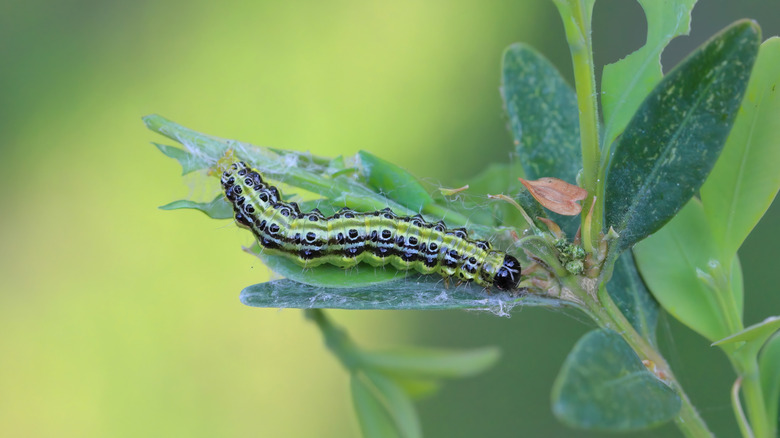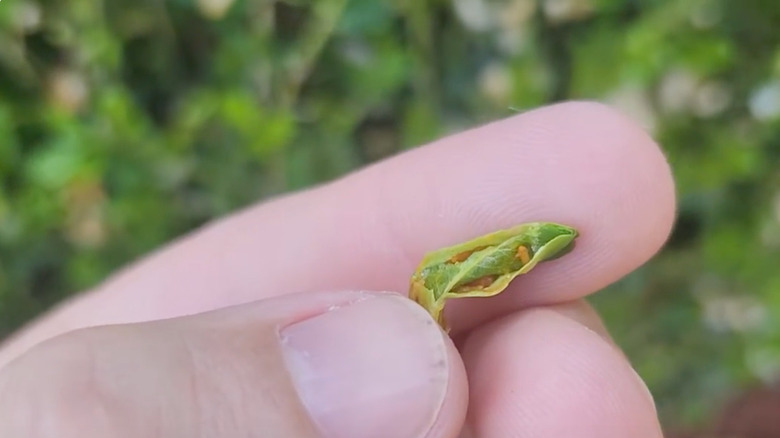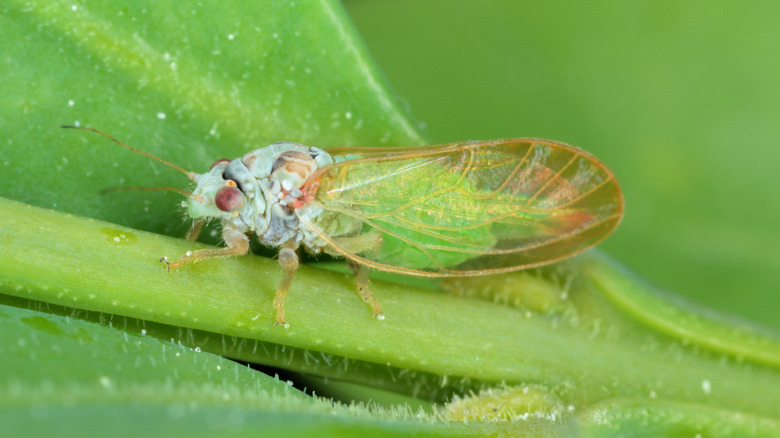Invasive And Harmful Pests Your Boxwood Tree Might Be Attracting
Boxwood (Buxus) trees and shrubs are celebrated for their versatility as accent plants and topiary, and perhaps even more for their functionality as hedges and borders. You can find many landscaping ideas for using boxwood plants for backyard privacy. With 90-plus species and 260 cultivars in multiple shapes and sizes, boxwoods offer gardeners lots of growing options. The downside is that several pests just love these plants; these include the boxwood leafminer, boxwood psyllids, boxwood mites, and most recently, the invasive box tree moth (Cydalima perspectalis). A significant, quickly spreading infestation was reported in 2025 in Cincinnati.
It's the larval caterpillar stage that does the damage, which can be devastating as they munch leaves aggressively down to the midrib. They even chew bark and girdle stems. Girdled and lacking leaves, the boxwood can die. Box tree moths feed from early spring to September, so generations of them can overlap and cause extreme damage. Box tree moth droppings that look like sawdust, webbing, and browning leaves are early signs of infestation. Of course, the caterpillars themselves will announce their presence with their lime-green color, accompanied by black stripes, white spots, hairs, and a black head with a shiny appearance.
Box tree moths and boxwood leafminers cause significant damage
This risk of significant damage can spread three to six miles annually. This is why every gardener should know how to stop the box tree moth in its tracks. For a small or early infestation, you can try hand-picking the caterpillars off the trees. For more serious attacks, you'll need chemical intervention, such as horticultural oils or insecticidal soaps. A wide variety of pesticides will kill the caterpillars. It's important, however, not to attempt any preventive application of pesticides. Apply pesticides only when you've identified an infestation, and when you apply, be sure to target the pests in their young caterpillar stage. Read and follow label instructions for any pest-control product you use. For the most severe infestations, you may need to employ a "cut-and-spray" technique in which you prune off defoliated areas when your boxwoods are dormant.
The boxwood leafminer (Monarthropalpusi flavus) is another common pest that can seriously damage your boxwood. While the adult leafminer is a fly resembling a gnat, both the pupa and larval stages do damage, and they do so in a particularly insidious way. Around May, the pupa stage mines through a blister between the top and bottom leaf layers from which adults emerge and lay eggs on the underside of leaves. Then, hatching larvae support their growth by continuing to dine on the leaf all summer.
If you see blistered, swollen, discolored leaves that sometimes drop off the tree, look for signs of a leafminer infestation. They are best identified in the pupae stage, in which they appear dark yellow, orange, or whitish. Control adult boxwood leafminers with contact insecticides containing bifenthrin, carbaryl, cyfluthrin, or malathion during the short window during which adults are emerging, or use systemic insecticide imidacloprid to control the larvae.
Watch for hard-to-spot boxwood mites and psyllids
Boxwood mites (Eurytetranychus buxi), a type of spider mite, are tiny –– barely visible to the naked eye. Unlike other spider mites, they munch from both the top and bottom of leaves. If you spot white lines that look like scratches on leaves — especially new leaf growth — you may be seeing boxwood-mite damage, as they eat in a line formation in the spring. However, you may not see these lines until later in the season. These pests have a short life cycle and can produce more than eight generations annually. Damage is largely limited to foliage discoloration, but boxwood mites can be treated twice in spring with insecticidal soap, horticultural oil, or products labeled as miticides.
Boxwood psyllids (Psylla buxi) are considered less destructive. These minor boxwood pests especially go after the Buxus sempervirens species, though any boxwood can host them. They damage boxwood leaves and buds by piercing and sucking sap from them. Cupping of the foliage is the major sign of damage, and within the cups, you may see waxy filaments and secretions produced by the pests, as well as the psyllids themselves in the form of light-green nymphs that may also display dark markings. Since damage is unlikely to affect the boxwood's overall health, small infestations don't require treatment. You can prune off damaged branch tips, and in the spring, use neem oil, insecticidal soap, or horticultural oil as new growth emerges. Pesticides can be applied for severe infestations.
Overlooking attention to boxwood pests is one of the mistakes everyone makes when growing boxwood. Be sure to monitor these pests on your boxwoods. You should also follow label instructions for any products used to control them.


